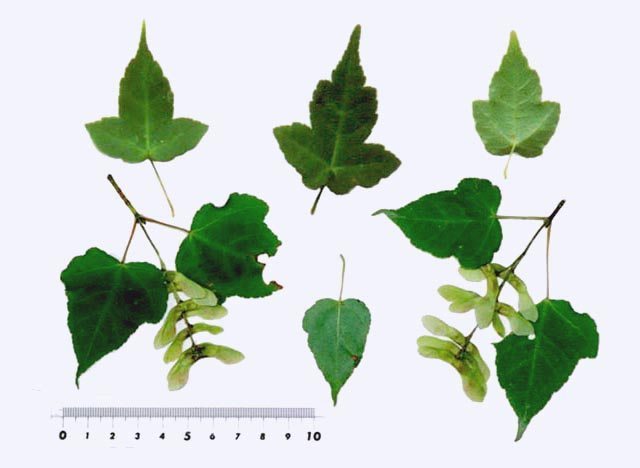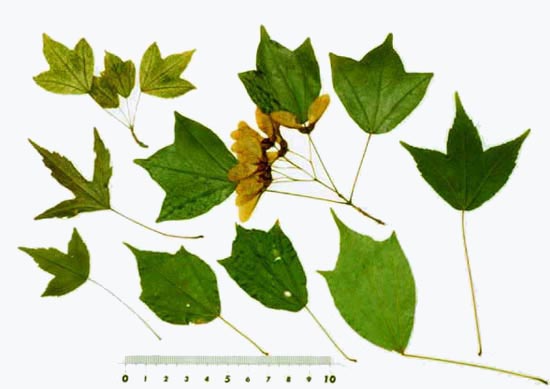
Leaves of A.crataegifolium (some lobes are clear, some are not clear)
Typical forms of leaves were shown in the former page, but such cases do not always occur. This page shows a basic thinking on discernment at first and shows that leaves don't have one pattern in their forms even in the same species.
How to recognize between maples and those which are not maples
As characters of maples, those would be the conclusive factors, that is, opposite raw of leaves and having samaras (a pair of seed with wings). In Japan, except Acer oblongum, they turn to red and/or yellow in Autumn, so if we find them having two characters mentioned above, they can easily identified as maples. But it is not unusual that most of samaras have finished falling after typhoons in fact by the golden age of autumn colors.
.As already mentioned, those maples are given as non-palmate ones in Japan, such as Acer distylum, Acer carpinifolium and Acer oblongum. As maples that have 3-leaflets, those are given such as Acer nikoense and Acer cissifolium.
Moreover, clearer distinction might be attained by a synthetic and systematical observation, such as the whole figure (height and branch stretching), bark, length and color of twigs, flower time, arrangement of flowers, form and color of flowers, the size of seed, arrangement of seed and angle of samaras(a pair of seed) in addition to the character of leaves.
Furthermore, according to species, some are monoecious and some are dioicous, or as for the number of chromosomes there is a difference between species, too. We would also like to expect some results for judgment by DNA. And, it should be considered that ecological observation, including character of distribution, is the base of species discernment.
Here, let me refer to more detailed discernment by a leaf we can do, under the above recognition. Let's enter the world where those Japanese sayings are valid such as "be particular about twigs, leaves and end-gnarls" or "to see a tree and not see forest". (As you know, sorry to say these sayings mean to stick to trifles, or not to see the whole. But even in such a little world, there might be a truth for those who are interested in.)
How to distinguish the species among maples by leaves
Character of leaf-form and factors except leaf-form
At first, it is required to know that leaves have errors in form even in a tree or in the same species when we try to discern a species by the form of a leaf.
As already mentioned, they will change with a place and its environmental condition in which they grow, moreover with parts of a wood to which a leaf is attached and with seasons when they appear.
Next, in a leaf there are many information on the characters of leaves for discernment except the whole form, such as degree of notches at margin of a leaf, color of back side of a leaf, feature of veins of a leaf, degree of hairiness, thickness of a leaf, gloss, touch & feeling character (like machine-made paper or Japanese paper) and their Fall color.
Generally speaking, there are many ambiguous elements, it is important to judge them synthetically. I think this discernment capability would be mainly relied on intuition, and would be cultivated from experiences by frequent seeing and direct touching in the garden or nature and through cultivation.
It is more natural to consider that it is difficult to understand theoretically only on a desk from one photograph or a figure from one vegetable illustrated book.
But it might be convenient for us to know the method of classification, that is, grouping of maples. If you would know those grouping such as section, series, subspecies, variety, form, you would be able to understand resembled characters of the group, and it will helpful for your discernment.
Here, let me show you various forms of leaves which are seen in the same species. It would be explained that the difference of these forms is owing to the combination of those factors such as its native character and its acquired causes including growth condition and environmental condition, etc.



Maples & Japanese maples : Species discernment